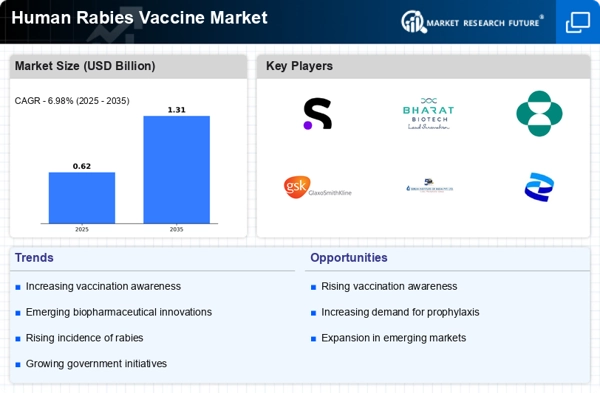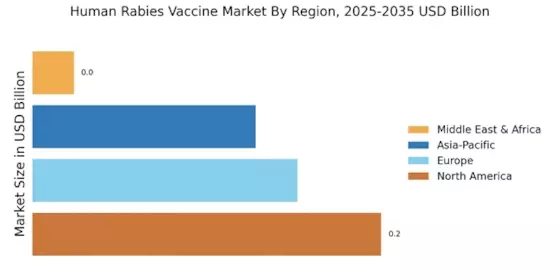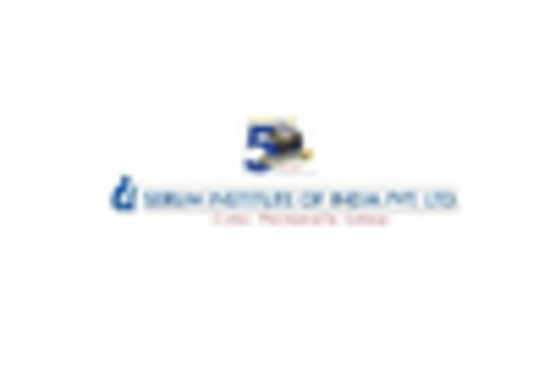Increased Travel and Migration
The rise in international travel and migration is likely to impact the Human Rabies Vaccine Market. As people travel to regions where rabies is endemic, the risk of exposure increases, prompting travelers to seek vaccination prior to their journeys. This trend is particularly evident among adventure travelers and expatriates who may encounter wildlife or stray animals. Consequently, the demand for pre-exposure rabies vaccination is expected to rise, driving market growth. Additionally, as migration patterns shift, public health authorities may implement vaccination programs to protect vulnerable populations, further contributing to the expansion of the Human Rabies Vaccine Market.
Rising Incidence of Rabies Cases
The increasing incidence of rabies cases in various regions appears to be a primary driver for the Human Rabies Vaccine Market. According to the World Health Organization, rabies causes approximately 59,000 deaths annually, predominantly in developing countries. This alarming statistic underscores the urgent need for effective vaccination programs. As awareness of rabies transmission through animal bites grows, public health initiatives are likely to emphasize vaccination as a preventive measure. Consequently, this heightened focus on rabies control may lead to increased demand for human rabies vaccines, thereby propelling market growth. Furthermore, the rising incidence of rabies in certain areas may prompt governments and health organizations to allocate more resources towards vaccination campaigns, further stimulating the Human Rabies Vaccine Market.
Government Initiatives and Funding
Government initiatives aimed at rabies elimination are likely to significantly influence the Human Rabies Vaccine Market. Various countries have implemented national rabies control programs, which often include vaccination strategies for both humans and animals. For instance, the Pan American Health Organization has reported substantial investments in rabies vaccination campaigns across Latin America. These initiatives not only enhance public health but also create a conducive environment for vaccine manufacturers. Increased funding for rabies prevention programs may lead to expanded access to vaccines, thereby driving market growth. Additionally, partnerships between governments and non-governmental organizations can facilitate the distribution of vaccines in underserved areas, further bolstering the Human Rabies Vaccine Market.
Growing Veterinary Vaccination Programs
The expansion of veterinary vaccination programs is anticipated to have a positive effect on the Human Rabies Vaccine Market. As pet ownership increases and awareness of zoonotic diseases grows, more pet owners are likely to vaccinate their animals against rabies. This proactive approach not only protects pets but also reduces the risk of rabies transmission to humans. Consequently, the demand for human rabies vaccines may rise as communities recognize the importance of herd immunity. Furthermore, collaboration between veterinary and human health sectors can enhance vaccination efforts, creating a synergistic effect that benefits the Human Rabies Vaccine Market.
Technological Innovations in Vaccine Production
Technological advancements in vaccine production are poised to transform the Human Rabies Vaccine Market. Innovations such as recombinant DNA technology and improved adjuvants have the potential to enhance vaccine efficacy and safety. These advancements may lead to the development of more effective vaccines that require fewer doses, thereby increasing patient compliance. Moreover, the ability to produce vaccines more efficiently could reduce costs, making them more accessible to populations at risk. As manufacturers adopt these cutting-edge technologies, the Human Rabies Vaccine Market may experience a surge in product offerings, catering to diverse consumer needs and preferences.


















Leave a Comment